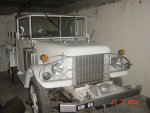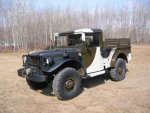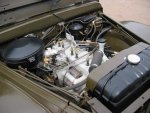I've done quite a bit of business with Bob Stahl of Veterans Vehicles out in Wrentham Mass. Bob is old guard --- no computer & no website but he is one of the most knowledgable people I've ever met in the M37 and civilian Power Wagon area. I'm almost certain that he has some 265s. I'm certain he has 251s. Bob is the guy that had the 489 gears made for the M37. His phone number is 508-384-7698.
The only thing I have to add concerning repowering an M37 with a long-block (251 or 265) flathead is that it is an easy mod. The radiator can be moved forward by simply installing the radiator on the other side of the mounting flange. The stock 230 flywheel, clutch, bellhousing, starter etc can be re-used. Be careful to use the m37 flywheel with the M37 starter as some of the 251 flywheels have different teeth counts. Outside of moving the motor mount and radiator forward and installing new exhaust it's a lot easier than installing a 318.
I personally gave up on trying to locate a 265 engine a couple of years ago. At one time I thought I had two engines located but both turned out to be 251s. I currently have two real nice 251 Spitfires in storage. Not long ago I was seriously considering selling all my trucks but recently I've changed my mind therefore I'll be balancing and building one of the 251s in the future.
In retrospect, I'm now of the opinion that the 251 is probably a better engine for my purposes than the 265. I'm running 36" rubber and 489 gears. According to my calculations, to run 65 MPH the engine has to produce 3,000 RPM! That's a lot or revs for an the 4-3/4 stroke 265. The 251 has a 4-1/2" stroke --- a characteristic that I feel is much more conducive to higher revs. If anyone disagrees with this in that they feel that the 4-3/4 stroke 265 ("balanced") engine wouldn't have any problems producing 3,000 RPMs please speak up.
Everyone I've talked to that's in the know say that the lower end on the 251 & 265 engines are a LOT stronger than the 230 engine. The only difference in the 265 over the 251 (except for some blocks that have full flow oiling systems) is the 265s 1/4" longer stroke. The crank and rods are different in the 265. Here are some comparatives:
230 Engine: 3.2500 Bore X 4.625 Stroke
251 Engine: 4.4375 Bore X 4.500 Stroke
265 Engine: 4.4375 Bore X 4.750 Stroke
As you can see, the 251 has a shorter stroke than both the 230 and the 265. People I've talked to say the 251 delivers appreciably more power over the stock 230. The 265 is a "real" powerhouse but like I said before, I don't know about running it above 2,500 RPM --- even when balanced. The 265s are also extremely scarce.
Because so many of these old engines have been rebuilt about the only way to tell for certain if an engine is a 265 is to measure the piston stroke or drop and pan and look at the crankshaft. The only part number used for the 265 crank is 1400188.
IF ANYONE KNOWS THE PART NUMBER FOR THE 265 RODS PLEASE PM ME.
The exhaust manifolds for the long block flatheads (251 & 265) engines are scarce as hens teeth.
The following block numbers were used for the 265:
1400929, 1402429, 1551229, 870744, 1402529, 1115829.
The following block numbers were used for both the 251 and the 265:
1400229, 1138129, 1115829
The following block umbers were used for the 251 only:
870729, 1400229
The following trucks offered the 265: (The 265 was built from 1955 thru 1961)
W500: 1957, 58, 59 & 60
D600: 1957, 58 & 59
D500: 1957, 58, 59 & 60
1955 - 1956: J6, JS6, JMC, K6, KA6, K5
1957: K6, W500, K6, D600, K6
1958: LS-D000, School Bus, LS-5600, LSW-500
1959: M6, D600, M6-5600, M6, W500
1960: P6, W500
1961: ?
I hope someone finds this information helpful.





